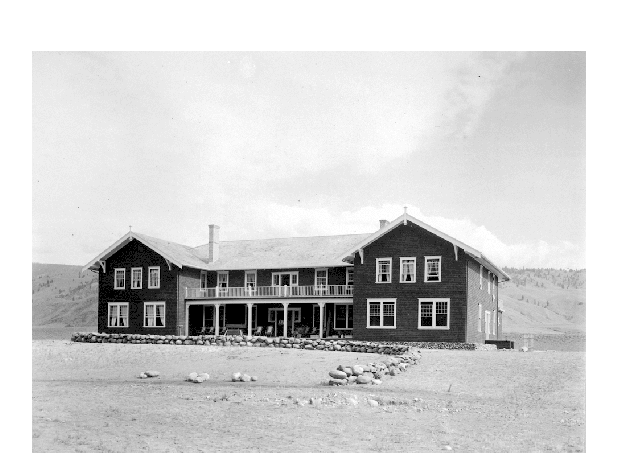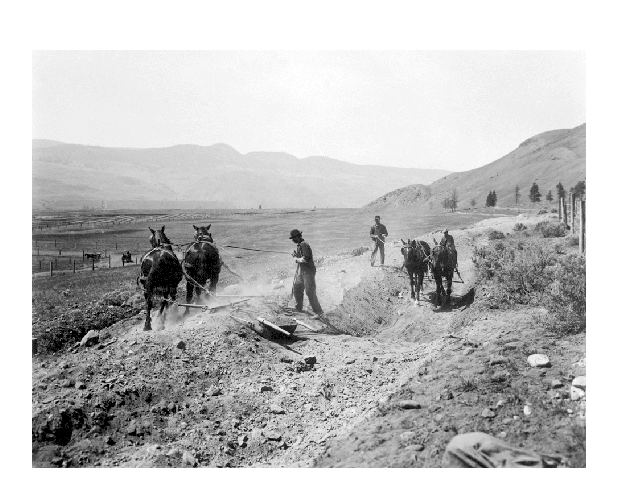
Walhachin, British Columbia
Encyclopedia

Thompson Country
The Thompson Country, also referred to as The Thompson and in some ways as the Thompson Valley and historically known as the Couteau Country or Couteau District, is a historic geographic region of the Southern Interior of British Columbia, based around the basin of the Thompson River, a tributary...
region of British Columbia
British Columbia
British Columbia is the westernmost of Canada's provinces and is known for its natural beauty, as reflected in its Latin motto, Splendor sine occasu . Its name was chosen by Queen Victoria in 1858...
, Canada
Canada
Canada is a North American country consisting of ten provinces and three territories. Located in the northern part of the continent, it extends from the Atlantic Ocean in the east to the Pacific Ocean in the west, and northward into the Arctic Ocean...
. It is located about 10 km west of Kamloops Lake
Kamloops Lake
Kamloops Lake in British Columbia, Canada is situated on the Thompson River just west of Kamloops. The lake is 1.6 km wide, 29 km long, and up to 152 m deep...
, and is 65 km west of Kamloops
Kamloops, British Columbia
Kamloops is a city in south central British Columbia, at the confluence of the two branches of the Thompson River and near Kamloops Lake. It is the largest community in the Thompson-Nicola Regional District and the location of the regional district's offices. The surrounding region is more commonly...
on the south shore of the Thompson River near Highway 1. The population is about 100 and the postal code is V0K 2P0.
In its heyday, from 1909 until 1914, this historic town was an affluent colony of English settlers and was often termed "Canada's Camelot".
History

But the true saga of Walachin would begin in 1907 when Charles Barnes, an American
United States
The United States of America is a federal constitutional republic comprising fifty states and a federal district...
entrepreneur, was working as a land surveyor at Ashcroft and visited Pennie's ranch and admired his 2 acres (8,093.7 m²) orchard
Orchard
An orchard is an intentional planting of trees or shrubs that is maintained for food production. Orchards comprise fruit or nut-producing trees which are grown for commercial production. Orchards are also sometimes a feature of large gardens, where they serve an aesthetic as well as a productive...
. Despite the fact that Walachin lies in the center of British Columbia's dry belt and has an average annual rainfall of less than 20 cm, Barnes envisioned thousands of acres of lush orchards and an elegant community of gentlemen farmers, primarily members of the English upper-class and aristocracy
Aristocracy
Aristocracy , is a form of government in which a few elite citizens rule. The term derives from the Greek aristokratia, meaning "rule of the best". In origin in Ancient Greece, it was conceived of as rule by the best qualified citizens, and contrasted with monarchy...
. For financial backing of this grand vision he contacted a company in England
England
England is a country that is part of the United Kingdom. It shares land borders with Scotland to the north and Wales to the west; the Irish Sea is to the north west, the Celtic Sea to the south west, with the North Sea to the east and the English Channel to the south separating it from continental...
, the British Columbia Development Association, who had already invested in several British Columbia properties including the ranch at 111 Mile House on the Cariboo Road
Cariboo Road
The Cariboo Road was a project initiated in 1860 by the colonial Governor of British Columbia, James Douglas...
. Barnes invited Sir William Bass
Sir William Bass, 2nd Baronet
Sir William Arthur Hamar Bass, 2nd Baronet was a British racehorse owner and a significant contributor to the racing industry. He also provided support for the British film industry in its early days....
, and an agriculturist and an engineer to come view the property. The men endorsed Barnes' plan and reported back to the BCDA that the land was a good investment and on January 21, 1908, they purchased the Pennie Ranch and an additional 930 acres (3.8 km²) parcel for $200 an acre for a total of $229,400. The BCDA then created two subsidiary companies, the British Columbia Horticultural Estates Limited to market the 10 acres (40,468.6 m²) plots of farmland, and the Dry Belt Settlement Utilities Limited to market lots on the 50 acres (202,343 m²) townsite. Charles Barnes became the manager of BC Horticultural Estates Ltd and purchased an additional 3265 acres (13.2 km²) from the Dominion Government for a dollar an acre.

Thompson language
The Thompson language, properly known as Nlaka'pamuctsin or the Nlaka'pamux language, is an Interior Salishan language spoken in the Fraser Canyon, Thompson Canyon, Nicola Country of the Canadian province of British Columbia, and also in the North Cascades region of Whatcom and Chelan counties of...
). However, when a thirty page pamphlet was printed in England, the name Walhachin was interpreted to mean "Bountiful Valley".
The advertising campaign was successful and most of the people who purchased the land were so convinced by the pamphlet's glowing reports that they bought the property sight unseen. An addition incentive was given to the new settlers when the Canadian government allowed them to bring in their personal effects without paying a duty
Duty (economics)
In economics, a duty is a kind of tax, often associated with customs, a payment due to the revenue of a state, levied by force of law. It is a tax on certain items purchased abroad...
. This was a major consideration to many of the newcomers, who would only consider moving to the Canadian wilderness if they could bring all the lavish comforts of home with them. Soon Barnes' vision of the elegant orchard community had been realized and all of the new land owners were titled or upper-class Englishmen.
Walhachin was no ordinary pioneer community, but boasted luxurious amenities that were nearly unheard of in other towns of the era. The Walhachin Hotel had an elegantly appointed dining room, three rotundas and offered quality accommodations. It also had a strictly enforced dress code.
Many of the townspeople lived in fine stone homes with high ceilings and large fireplaces and had servants, maids and valet
Valet
Valet and varlet are terms for male servants who serve as personal attendants to their employer.- Word origins :In the Middle Ages, the valet de chambre to a ruler was a prestigious appointment for young men...
s. In town, there was a Chinese laundry, a polo
Polo
Polo is a team sport played on horseback in which the objective is to score goals against an opposing team. Sometimes called, "The Sport of Kings", it was highly popularized by the British. Players score by driving a small white plastic or wooden ball into the opposing team's goal using a...
field, a swimming pool
Swimming pool
A swimming pool, swimming bath, wading pool, or simply a pool, is a container filled with water intended for swimming or water-based recreation. There are many standard sizes; the largest is the Olympic-size swimming pool...
, a skating rink
Skating rink
A skating rink may refer to:* an ice rink used for ice skating* a roller rink used for roller skating...
and tennis courts.

Flume
A flume is an open artificial water channel, in the form of a gravity chute, that leads water from a diversion dam or weir completely aside a natural flow. Often, the flume is an elevated box structure that follows the natural contours of the land. These have been extensively used in hydraulic...
that would carry water down the mountainside to irrigation ditches. By April 1910, they had built 12 miles (19.3 km) of flume and ditches on the north bank of the Thompson River
Thompson River
The Thompson River is the largest tributary of the Fraser River, flowing through the south-central portion of British Columbia, Canada. The Thompson River has two main branches called the South Thompson and the North Thompson...
, but due to improper construction of the flume and shaky trestles, it couldn't carry as much water as was needed to irrigate the orchards during excessively dry periods. Nevertheless, the community persevered and by 1914, there were 300 residents.
Despite the hardships and trials that these newcomers faced, it was not through their weakness or lack of knowledge that the dream of Walhachin failed, but the onset of the Great War which caused many of many of the British
United Kingdom
The United Kingdom of Great Britain and Northern IrelandIn the United Kingdom and Dependencies, other languages have been officially recognised as legitimate autochthonous languages under the European Charter for Regional or Minority Languages...
residents to return home to fight for their country. Most would never return and by 1922 the last resident of Walhachin had left.
Recent activity is the quarrying of rock, close above the townsite, for railbed ballast. Residents are occasionally bombarded by flying stone debris from the blasting operations. This quarry can be seen from Highway 1 as a black scar on the hillside above the town. As this area is cattle ranching country, much of the arable, flat land is planted to alfalfa for winter hay. The hot, dry climate, and irrigation water from the river, enable two or three crops each summer.
Further reading
- Walhachin:Catastrophe or Camelot? Joan Weir ISBN 0-88839-982-0
- Ghost Towns of British Columbia Bruce Ramsey Mitchell Press, Vancouver, 1963, OCLC: 39371 ISBN Unknown
External links
- Information on Walhachin
- http://www.walhachin.com/default.htm A great local site, 150 year anniversary in 2008

